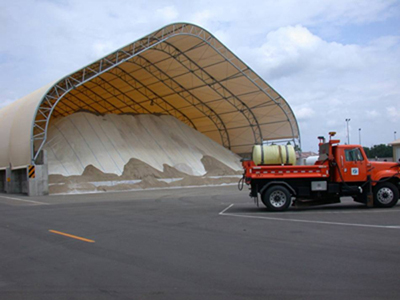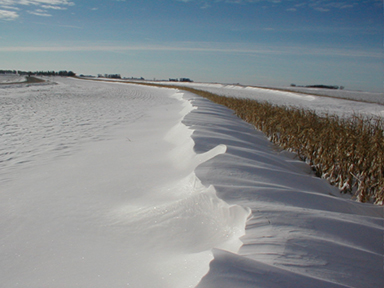In the face of extreme winter weather, escalating costs, and tighter budgets, the Minnesota Department of Transportation is implementing more sustainable solutions for coping with ice and snow on the state’s roadways.
Wintertime highway maintenance operations can be expensive. Like other cold weather states, MnDOT must purchase salt-based anti-icing and de-icing materials, pay for the fuel for plow trucks, and compensate employees. Annual salt applications also take a toll on transportation infrastructure by accelerating bridge corrosion and road surface deterioration. Furthermore, the winter maintenance can have an impact on roadside plant life and the water quality of streams, lakes, and rivers.
MnDOT has a commitment to the more efficient uses of salt and other de-icing and anti-icing compounds as a means to better environmental stewardship and to cut costs. The agency has demonstrated over recent years that winter operations can be effective at removing ice and snow from road surfaces while reducing the use of anti-icing compounds.
MnDOT began to address wintertime salt use in the mid 1990s as a way to reduce maintenance costs, according to Steve Lund, the State Maintenance Engineer with the department. As the program evolved over time, the environmental benefits naturally became apparent; safety, environment, and cost savings now are all given consideration, Lund said.

Innovative Practices Reduce Use of Salt and Brine
MnDOT has put in place a number of innovations to reduce the amount of salt and brine in road maintenance. The training of plow drivers and district support staff has been a key part of this effort. The department’s program uses plow truck simulators and classroom work on salt alternatives and application rates to teach snowplow operators what they need to know for the best results.
“Making sure that operators understand the cost savings issues and the environmental issues” regarding salt use is first and foremost with the program, Lund said.
The department also is trying various types of new equipment that will help to improve salt application while reducing costs and operator effort. Calibration scales streamline the calibration of spreading equipment so that application rates can be maintained more easily. Portable blending stations allow for the mixing of granular salt with deicing solutions close to the roadways that need it most.
In addition, computer-aided systems allow for the accurate blending of deicing chemicals as needed, rather than storing blends in tanks. Pre-wet salt, heated salt, and liquid deicing chemical additives can melt snow and ice faster, reducing the amount of salt used. Finally, the department is using devices such as a tailgate shaker that prevents the clumping of salt, and lightweight plow blades and tow plows that can remove snow and slush more efficiently.
Maintenance Decision Support System
Aiding in all of these efforts is the department’s maintenance decision support system (MDSS). The system involves a computer in the cabs of the plow trucks that uses real-time weather forecast data together with data on truck operations to produce suggested salt application rates and plowing cycle frequency, according to Lund. Data are recorded for use later in operator training and to inform the winter maintenance records, Lund said. For example, MnDOT hopes to use the MDSS data in conjunction with its the Winter Severity Index to provide a more normalized set of metrics by which to measure salt use from year to year.
“We’re a believer in it,” said Lund, suggesting that the MDSS would benefit other cold weather states.
These innovative practices helped the department reduce the application of salt by approximately 49,000 tons during the winter of 2009-2010, as compared to the previous winter, and 20.6 percent less than the 10-year average. This reduction occurred despite the fact that the winter was slightly above average based on the state’s Winter Severity Index, which ranks winters on a scale of 0 to 100 using weather timing and duration criteria.
While the department had to increase its use of salt and brine during the severe winter of 2010-2011, it was able to keep salt use down at levels used during the much less severe winter of 2005-2006.
The cost of salt has been trending upward over the last decade, making cost containment very important. The reduced use in 2009-2010 saved an estimated $3 million in salt costs alone. Per lane mile cost was $284 less in 2009-2010 than the previous year, according to department data.
In addition, there are long term infrastructure savings to be realized. Using salt and brine effectively will extend the life of pavements and bridges, reducing the frequency of maintenance or replacement.
Natural Barriers to Drifting Snow
The prevention of drifting snow is another way to keep Minnesota highways drivable in the wintertime. Living snow fences—barriers made of trees, shrubs, native grasses, or crops planted along roads—are increasingly being used by MnDOT.
Properly designed and placed, these living barriers trap snow that blows across the landscape, preventing big snowdrifts from stranding motorists and improving visibility to reduce accidents. They also reduce spending on plows and help reduce shipping delays for goods and services.

MnDOT is working with the U.S. Department of Agriculture and local landowners adjacent to roadways to promote the installation of living snow fences.
MnDOT annually purchases standing corn rows from area farmers to serve as snow fences adjacent to sections of highways that have a history of blowing and drifting snow. Corn needs to be planted parallel to the road to serve as a fence. A typical corn row snow fence is one-quarter-mile long and 16 rows wide covering an average of 1.2 acres and is set back 120 to 240 feet from the highway right-of-way. Based upon the estimated corn yield per acre, MnDOT will pay an additional $1.50 per bushel above the local elevator price for corn.
About 30 miles of fences have been installed so far, but MnDOT has identified an additional 1,200 miles of highway with chronic snow drifting problems.
On average, every dollar spent on implementing the living snow fence practice yields a $17 return, according to MnDOT.
“No question they provide us real results,” Lund said.
A wide range of information is available on the Mn/DOT road maintenance website, http://www.dot.state.mn.us/maintenance/. Additional information also is available by contacting Steve Lund at (651) 366-3566, [email protected], or Cindy Carlsson at (651) 366-4824, [email protected]. (Photos courtesy of MnDOT)